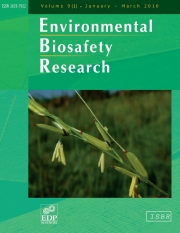Crossref Citations
This article has been cited by the following publications. This list is generated based on data provided by
Crossref.
Fuchs, Marc
Chirco, Ellen M.
Mcferson, Jim R.
and
Gonsalves, Dennis
2004.
Comparative fitness of a wild squash species and three generations of hybrids between wild×virus-resistant transgenic squash.
Environmental Biosafety Research,
Vol. 3,
Issue. 1,
p.
17.
PAPARINI, ANDREA
and
ROMANO-SPICA, VINCENZO
2006.
Gene Transfer and Cauliflower Mosaic Virus Promoter 35S Activity in Mammalian Cells.
Journal of Environmental Science and Health, Part B: Pesticides, Food Contaminants, and Agricultural Wastes,
Vol. 41,
Issue. 4,
p.
437.
Fuchs, Marc
and
Gonsalves, Dennis
2007.
Safety of Virus-Resistant Transgenic Plants Two Decades After Their Introduction: Lessons from Realistic Field Risk Assessment Studies.
Annual Review of Phytopathology,
Vol. 45,
Issue. 1,
p.
173.
Morroni, Marco
Thompson, Jeremy R.
and
Tepfer, Mark
2008.
Twenty Years of Transgenic Plants Resistant toCucumber mosaic virus.
Molecular Plant-Microbe Interactions®,
Vol. 21,
Issue. 6,
p.
675.
Chandler, Stephen
and
Dunwell, Jim M.
2008.
Gene Flow, Risk Assessment and the Environmental Release of Transgenic Plants.
Critical Reviews in Plant Sciences,
Vol. 27,
Issue. 1,
p.
25.
Fuchs, M.
2008.
Encyclopedia of Virology.
p.
156.
Quemada, Hector
Strehlow, Laura
Decker-Walters, Deena S.
and
Staub, Jack E.
2008.
Population size and incidence of virus infection in free-living populations ofCucurbita pepo.
Environmental Biosafety Research,
Vol. 7,
Issue. 4,
p.
185.
Laughlin, Karen D.
Power, Alison G.
Snow, Allison A.
and
Spencer, Lawrence J.
2009.
Risk assessment of genetically engineered crops: fitness effects of virus‐resistance transgenes in wild Cucurbita pepo.
Ecological Applications,
Vol. 19,
Issue. 5,
p.
1091.
Bulajic, Aleksandra
Vucurovic, Ana
Stankovic, Ivana
Ristic, Danijela
Berenji, Janos
and
Krstic, Branka
2010.
Novel approaches to implementation of pumpkin resistance in control of viral diseases.
Pesticidi i fitomedicina,
Vol. 25,
Issue. 3,
p.
201.
Oliver, Jonathan
Tennant, Paula
and
Fuchs, Marc
2011.
Transgenic Horticultural Crops.
p.
263.
Prendeville, Holly R.
Ye, Xiaohong
Jack Morris, T.
and
Pilson, Diana
2012.
Virus infections in wild plant populations are both frequent and often unapparent.
American Journal of Botany,
Vol. 99,
Issue. 6,
p.
1033.
Bravo-Almonacid, Fernando
Rudoy, Valeria
Welin, Bjorn
Segretin, María Eugenia
Bedogni, María Cecilia
Stolowicz, Fabiana
Criscuolo, Marcelo
Foti, Marcelo
Gomez, Maximiliano
López, Mariana
Serino, Germán
Cabral, Silvia
Dos Santos, Cristina
Huarte, Marcelo
and
Mentaberry, Alejandro
2012.
Field testing, gene flow assessment and pre-commercial studies on transgenic Solanum tuberosum spp. tuberosum (cv. Spunta) selected for PVY resistance in Argentina.
Transgenic Research,
Vol. 21,
Issue. 5,
p.
967.
Rastogi Verma, Smita
2013.
Genetically Modified Plants: Public and Scientific Perceptions.
ISRN Biotechnology,
Vol. 2013,
Issue. ,
p.
1.
Scorza, Ralph
Kriss, Alissa B.
Callahan, Ann M.
Webb, Kevin
Demuth, Mark
Gottwald, Tim
and
Vinatzer, Boris Alexander
2013.
Spatial and Temporal Assessment of Pollen- and Seed-Mediated Gene Flow from Genetically Engineered Plum Prunus domestica.
PLoS ONE,
Vol. 8,
Issue. 10,
p.
e75291.
Liu, Yong-Bo
Darmency, Henry
Stewart, C. Neal
Wei, Wei
Tang, Zhi-Xi
and
Ma, Ke-Ping
2015.
The effect of Bt-transgene introgression on plant growth and reproduction in wild Brassica
juncea
.
Transgenic Research,
Vol. 24,
Issue. 3,
p.
537.
Simmons, H. E.
Prendeville, H. R.
Dunham, J. P.
Ferrari, M. J.
Earnest, J. D.
Pilson, D.
Munkvold, G. P.
Holmes, E. C.
and
Stephenson, A. G.
2015.
Transgenic Virus Resistance in Crop-WildCucurbita pepoDoes Not Prevent Vertical Transmission ofZucchini yellow mosaic virus.
Plant Disease,
Vol. 99,
Issue. 11,
p.
1616.
Wu, Meng
Lewis, Jamicia
and
Moore, Richard C.
2017.
A wild origin of the loss‐of‐function lycopene beta cyclase (CYC‐b) allele in cultivated, red‐fleshed papaya (Carica papaya).
American Journal of Botany,
Vol. 104,
Issue. 1,
p.
116.
Klocko, Amy Leigh
2020.
Strategies to facilitate containment of genetically engineered crops.
CABI Reviews,
Holeva, Maria C.
Sklavounos, Athanasios
Rajeswaran, Rajendran
Pooggin, Mikhail M.
and
Voloudakis, Andreas E.
2021.
Topical Application of Double-Stranded RNA Targeting 2b and CP Genes of Cucumber mosaic virus Protects Plants against Local and Systemic Viral Infection.
Plants,
Vol. 10,
Issue. 5,
p.
963.
Monnot, Severine
Desaint, Henri
Mary-Huard, Tristan
Moreau, Laurence
Schurdi-Levraud, Valerie
and
Boissot, Nathalie
2021.
Deciphering the Genetic Architecture of Plant Virus Resistance by GWAS, State of the Art and Potential Advances.
Cells,
Vol. 10,
Issue. 11,
p.
3080.


